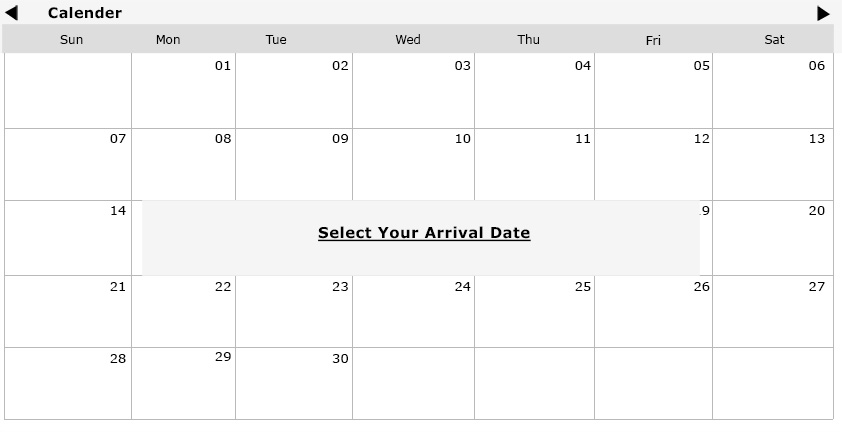Day 1: Arrive at Delhi - most flights arrive either in the evening or at night, and we
strongly recommend that our guests consider arriving a day earlier as this allows you to recuperate from jetlag, and serves as insurance against international flight delays and cancellations. The cost of an additional nights Hotel stay can be quoted upon request.
Our services begin here. You are greeted at the airport by an Easy Tours Travel Facilitator and ushered to a chauffeur driven vehicle. You are then driven to your hotel and assisted with your check-in. The next day’s plans are briefly reviewed and you are presented with your welcome package. This package includes travel documents such as your air tickets and hotel vouchers, as well as copies of documents (such as our General Travel Guide) that were sent to you earlier.
Day 2: Delhi. Begin your exploration of India with a guided city tour of Old Delhi. This excursion begins with the amazing Red Fort. Both the Jama Masjid (Mosque) and this massive structure were built by Shah Jahan, the emperor who created the Taj Mahal.
The great city inside the massive sandstone walls of the Red Fort offers visitors a large number of architectural and historical attractions; it was once known as the 8th wonder of the world. The Red Fort was the seat of the Mughal Empire for more than two hundred and fifty years and is also a UNESCO World Heritage Site. It is an amazing example of a blend of Persian, Indian and European architecture. One of your most vibrant and enduring memories
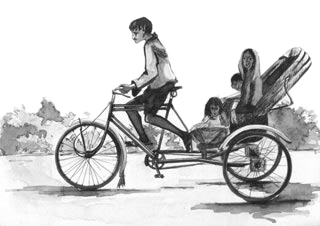
of India will be your next experience as you drive, walk and ride through the ancient city's streets and alleys for a couple of hours. You will enjoy a fascinating rickshaw ride, and extended walk with your guide through the crowded ancient alleys of Chandni Chowk. The cacophony of sounds both ancient and modern from the cries of hawkers and the animated bargaining that have echoed through the centuries, to the modern motor horns, the riot of colors from spices to saris, and the equally diverse smells emanating from the street food stalls and spice markets that form part of the bazaar, this is truly an assault on the senses at every level. Next is an exploration of the Jama Masjid (1650 A.D.), the largest mosque in India. The Masjid (Mosque) is a magnificent example of Mughal architecture and is constructed of red sandstone and white marble. It is an active place of worship and its courtyard can hold 25,000 worshippers.
There is a break for lunch.
After lunch a short drive will deliver you to an oasis of calm and serenity, which also happens to be your last destination in Old Delhi. The cremation site of Mahatma Gandhi (Raj Ghat) is a simple yet stirring memorial to the father of the nation. Lush lawns extend beyond the enclosure surrounding the black marble platform occupying the spot where the Mahatma was cremated. An eternal flame burns next to the platform.
After this
you will drive to
National Museum, the crown jewel of India’s Museums, for a very short tour. If museums are
not your cup of tea, your Guide will offer alternatives to this highly recommended experience. The museum is charged in its mission statement with being “the epitome of national identity”, a goal that it undoubtedly achieves. There is a plethora of exhibits and artifacts and a comprehensive tour would take well over a day. Our
visit will be brief, and your Guide will walk you through the Pre History Gallery’s Harrapan Collection and its displays from the Indus Valley Civilization, which flourished on the banks of the river of the same name. Most visitors to India are unaware of the fact that this was the most advanced and widespread of the world’s three oldest civilizations, and that the nation of India derived its name from this magnificent river. You will be amazed by the sophistication of the exhibits of pottery, tools, coins, jewelry and other artifacts that range from
10,000 BC to 1000 BC. Please let us know if you would like a more extended visit while finalizing your tour reservation process.
From the museum you will be driven back to your hotel.
Day 3: Delhi. Continue your exploration of Delhi with a guided city tour of New Delhi. This tour begins with a drive through Lutyens’ New Delhi. This drive will include photo opportunities at the following attractions - the exterior of the massive and awe-inspiring Rashtrapati Bhawan (known as Viceroy’s House during the British era) and Delhi’s landmark structure India Gate. From here you will be
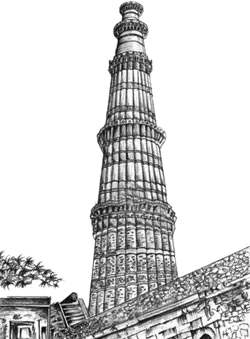
driven to visit the Bangla Sahib Gurudwara.
This gold domed Sikh Temple is the most prominent Gurudwara in Delhi and is associated with the eighth Sikh Guru, Guru Har Krishan. It was first built as a small temple by Sikh General Sardar Bhagel Singh in 1783, who supervised the construction of nine Sikh shrines in Delhi during the reign of Mughal Emperor Shah Alam. The campus includes the temple, a kitchen, a school, an art gallery, and the holy pond (Sarovar), whose water is called Amrit (Holy Nectar). As with all Sikh Gurudwaras, the concept of langar (community meal) is practiced here and anyone may eat in the Gurudwaras Kitchen. Thousands of meals are prepared daily and served to all visitors, regardless of race, religion or other status. The food is prepared by the religious leaders who are assisted by scores of local volunteers. You will witness the fascinating processes of cooking, serving and cleanup for these countless meals. Only vegetarian food is served, so that no religion’s dietary restrictions are violated. After the langar ceremony, you will drive through Connaught Place, which is New Delhi’s downtown.
There is a break for lunch.
After lunch, you will drive to visit the magnificent tomb of the Mughal Emperor Humayun.
Delhi has such an abundance of amazing monuments that this Tomb Complex (1562 A.D.) does not quite get the acclaim that it deserves. It is Delhi’s third UNESCO World Heritage Site and its amazing architecture and the elaborate gardens will captivate you as your guide explains the unique architectural and historic facets of this monument.
The last part of this excursion is the awe-inspiring Qutab Minar (1193 A.D.). This 239 ft tall medieval tower is a symbol of victory and a beautiful example of Persian architecture from that period. There is a winding stairway inside the tower that goes up all the way to the balcony at the very top of the tower – unfortunately they are no longer accessible for visitors. The Qutab Minar and its Monuments are also a UNESCO World Heritage Site.
Within the Qutab complex, amidst the ruins of the Quwat-ul-Islam Mosque, stands one of the legendary Ashoka Pillars. This large iron pillar has withstood the ravages of Delhi’s weather (and recent pollution) and has not rusted in over 1500 years.
After exploring the Qutab Minar you will be driven back to your hotel.
Day 4: Delhi - Agra. Check-out from your hotel in the mid-morning and you are driven to Agra on North India’s newest highway. Arrive at Agra and there is a break for lunch. After lunch, you will be driven to your hotel for check-in.
Afternoon - you will visit the first red sandstone fort of North India, the Agra Fort, a UNESCO World Heritage Site. It was built in 1565 by India’s greatest Mughal ruler, Emperor Akbar. Its royal audience halls, immense stone courtyards, marble mosque and the private royal chambers give us a glimpse of the grandeur of the Mughal Empire.
Enjoy a sunset visit to one of the Seven Wonders of the World, the incomparable Taj Mahal. The world’s greatest monument dedicated to love is obviously a UNESCO World Heritage Site. The Taj Mahal was completed by Emperor Shah Jahan in 1653 A.D. as a memorial to his beloved queen Mumtaz Mahal. This spectacular white marble mausoleum was created by about 22,000 skilled craftsmen and it took twenty two years to complete. When you experience the Taj Mahal with an Easy Tours Tour Guide who shares unique insights into its innumerable facets, some of their passion for this masterpiece may rub off on you. Explore the amazing Taj and its surroundings until it is time to admire the sun’s rays setting on the façade of the world’s finest monument.
Day 5: Agra - Jaipur. Enjoy a visit to the magnificent Taj Mahal at sunrise - the best time to see it during most of the year! Due to it being more expensive for Indian tourists at that time,
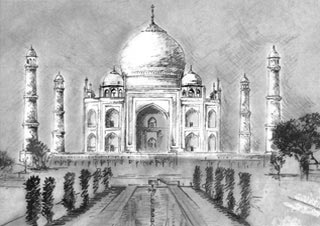
and the early hour, the massive monument and its surrounding Mughal gardens are a lot less crowded than in the afternoon. As the rising sun’s rays illuminate the precious stones inlaid in the marble, they will gleam momentarily as the marble’s color changes. You will return to your hotel to freshen up and have breakfast after the excursion.
Check-out from your resort and then you are driven to the Chand Baori stepwell at
Abhaneri, located just off the Agra – Jaipur highway. You can either get a packed meal from your hotel, or, before your arrival at Abhaneri, you have the option to stop for lunch at a reasonably priced nature resort that serves local cuisine. Chand Baori is a unique monument that is located next to a charming Rajasthani village. Please note that the local guides in Abhaneri are not as proficient in the English language as the guides you will have in other destinations, and their accents can be hard to understand. The massive 10th century
Chand Baori stepwell is one of the most impressive in all of India. The depth of the stepwell is that of a modern 7 storey building, and there are stairs leading down to the bottom from three of the 100 foot plus (35 meters) four sides of the opening. Enjoy a guided exploration of the stepwell and then you will walk through the small village to get a glimpse of the lives of the simple but proud
Rajasthani villagers. There will be young boys and girls herding goats, sheep, and cows around the area, camels carrying loads for their owners, and many other experiences that are only found in rural India. There are potters huts that you can stop at, as well as ladies weaving traditional garments, as well as opportunities to view many other indigenous activities. This is not a disguised effort to sell local wares, as is often found in tourism destinations. These are real villagers, and their simplicity, warmth, and hospitality will captivate you.
After this you will
continue on with your journey to Jaipur. Check-in at your gorgeous hotel upon your arrival at Jaipur.
Day 6: Jaipur. Start your day with an excursion to the Amber Fort and Palace, a UNESCO World Heritage Site, located a short distance from the walled city. Just like the Emperors of a few centuries ago, enjoy the ascent up to the ramparts of the fort on top of a colorfully caparisoned elephant. If you prefer not to ride the elephants, you can be driven to the rear entrance
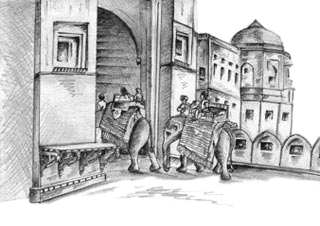
of the monument. The massive Fort complex was originally built by Raja Mansingh and is one of India’s finest examples of Rajput architecture. Explore the chambers and hallways, which are famous for their exquisite designs and handcrafted embellishments. Return to the valley beneath the Fort and
there is a break for lunch.
You are now driven to the outskirts of Jaipur to the ancient Hindu pilgrimage site of Galtaji in the Aravalli Hills. The complex of temples here is collectively known as the Monkey Temple because a large tribe of monkeys lives here and believes they own all the monuments. We recommend that you don’t carry any food in your hands, as it may be snatched away. The complex of temples has several ponds that are fed by springs on the hill tops, and Hindu pilgrims consider taking a dip in these to be purifying. The monkeys agree and swim around the main pond with reckless abandon, and many of them can be seen
diving into the pool from various vantage points.
Enjoy a guided tour of the beautiful Galtaji Temple, which is crafted in pink stone. There are other ancient temples in the complex, such as the Balaji Temple. Monkeys are everywhere, and they are obviously in-charge! For someone not used to their social behavior and grooming practices and rituals, observing them can be fascinating. If you are up to a trek and have the time, you can climb to the top of the tallest hill in the area and visit the Sun Temple.
After this excursion, you will be driven back to your hotel.
Day 7: Jaipur. Continue your adventure with an exploration of the walled pink city of Jaipur, including its magnificent City Palace. You will start with a visit to Jantar Mantar (a UNESCO World Heritage Site), a fascinating stone observatory built by Raja Jai Singh in 1728. Among other instruments, it includes a massive stone sun dial that is accurate to within 2 seconds. After the observatory comes a photo opportunity at the Hawa Mahal (Palace of the Wind). This intriguing facade was built in 1799 so that the ladies of the court could use its unique windows and observe the bustling bazaar without being visible to the people on the streets. Continue the tour with an exploration of the City Palace, the former royal residence (a part is still occupied by the Royal family and is not accessible to the public), built in a delightful blend of Rajasthani and Mughal architectural styles. Your guide will regale you with stories of royalty as you admire their trappings. This immense complex also houses a number of museums that offer a large and impressive collection of costumes, armory and miniature paintings, and brief visits to these can be a part of your late morning.
There is a break for lunch.
During the early afternoon you will enjoy an extended guided walk through the “pink” bazaar in the heart of the old town, and watch the locals as they bargain for their everyday necessities. You will walk through spice, vegetable, fruit and flower markets which are interspersed with street food stalls, displays of clothing and footwear spread all over the sidewalks, an alley full of artisan’s hawking local jewelry and accessories, and a lot more.
In the bazaar area you will also enjoy a brief stop for a tour of a collection of vibrant Rajput turbans. A turban tying demonstration is included, as are turban and Sari tying lessons for those that are interested.
In the latter part of the afternoon you are driven to a very scenic location in Jaipur adjacent to a public park, for a guided exploration of The Albert Hall Museum, which was completed in 1887 by the architect Samuel Swinton Jacob. Its origins lie in the suggestion to open a museum of the Industrial Arts, which would acquaint local craftsmen with the best examples of art work and handicrafts of India. It was hoped that this would inspire them to improve their own skills, thereby protecting and preserving traditional arts, while providing greater employment for artisans. It was also the intention that the display would help to educate youth in a wide variety of fields, entertain and inform the people of Jaipur. Rudyard Kipling (himself the son of a curator) on a visit was so impressed by the architecture, woodwork, display, exhibits, cleanliness, and not least the curator’s office that he wrote "it is now a rebuke to all other museums in India from Calcutta downwards".
Return to your hotel in the evening.
Day 8: Jaipur - Pushkar. Check-out from your hotel after breakfast and then you are driven to Pushkar. Arrive at Pushkar around noon and you are assisted with check-in at your desert lodge.
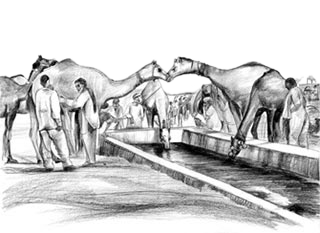
Please note that, although it is one of the best adjacent to the Pushkar Festival Fairgrounds, your lodging for this night is basic and will not have anywhere near the luxury of your other hotels in India. There will be a staffed Easy Tours Facilitation Center in the lobby of the desert lodge to assist you for any needs that may arise.
There is a break for lunch. All 3 meals are at your lodge while you are at Pushkar.
Afternoon - Experience a camel cart ride to the cattle trading fairgrounds. Walk through the Fair camp grounds with Easy Tours guides and Tour Directors to experience the cattle trading and everything else that goes on at this massive fair. The trading activity is at its peak during this part of the fair and you will experience rural Rajasthan as one can only do during this massive cattle fair - photo and video opportunities are endless. Thousands of camels, horses, and other cattle will be traded within a few days. The cattle are groomed and decorated, their skills and strengths are demonstrated in various ways, and there is intense haggling. A plethora of street vendors are mixed in with all this activity, selling food to the villagers and fodder for the various cattle.
At the end of the day the trading ceases and the thousands of villagers settle down to discuss the day’s exploits, and to prepare for their evening meal. At this time, as the sun sets in the desert, you will return to your lodge by camel cart.
Day 9: Pushkar - Delhi - International Flight. If you want to experience the early morning activities at the Fair you can have an early breakfast and join your guide for a visit to the fairgrounds, where you will walk through the awakening campground and observe the villagers as they prepare for the day.
Return to your lodge to freshen up. Y
ou are driven to the small town of Pushkar, where you will
walk through its crowded and colorful alleys this morning. This is a pilgrimage destination and you will see temples that are a hubbub of activity during this auspicious period. There is usually a colourful religious procession that goes through the alleys this morning, but this events schedule can change and so it is not guaranteed. Visit the holy lake in the middle of town where pilgrims are taking a dip to wash away their sins.
Board your vehicles again and you are led to a spot where your caravan of camels awaits. You are assisted in climbing on your personal camel (camel carts are also available) and then you proceed on a camel safari through the semi-arid region near Pushkar. Your safari ends at a venue where you are the guests of honor at an Easy Tours sponsored Camel Race.
Experience the fascinating race where some camels will develop a mind of their own and head in every other direction but the finish line. You will be amazed by the speed and grace of these awkward looking animals as they fly over the sand.
Return to your lodge and freshen up.
You are assisted with your check-out from your desert lodge by noon and then you are driven to the Jaipur airport in time to board your late afternoon flight to Delhi – a packed lunch is provided from your hotel. Arrive at Delhi airport and collect your baggage, then check-in for your international flight.
If your international flight departs late at night or the very early next morning, we recommend that we reserve a room for you at the Holiday Inn Express in-terminal hotel, priced very reasonably, and located inside the international terminal. If you and the greeter do not connect, do not go outside the terminal. Instead, simply ask airport staff for directions to the hotel and you can proceed there on your own. Please note that you will not be able to take your checked baggage in to your room as it will be stored by the hotel. The hotel has decent dining facilities and a relatively inexpensive spa. At the appropriate time for your international flight check-in a Holiday Inn representative will assist with your check-out and escort you to your check-in counter for your international flight.
If your flight departs the next day, airport transfers and an additional nights hotel stay near the airport can be easily arranged.
Our services end at Jaipur airport. 